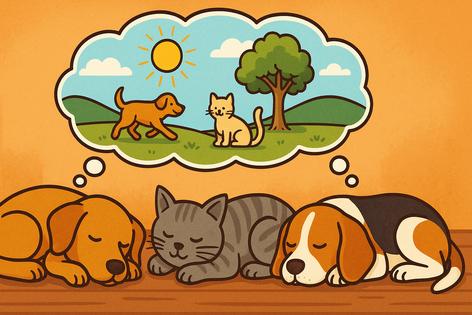Snoozing Scientists: What Pet Sleep Reveals About the Brain
Published in Cats & Dogs News
Dogs and cats spend a striking share of their days asleep. That downtime is not wasted; it is when their brains consolidate memories, reset emotional circuits and perform basic maintenance that keeps thinking sharp. Researchers have learned that the structure of canine and feline sleep looks a lot like ours, which makes the living room nap an unexpected window into mammalian neuroscience.
How much they sleep — and why it matters
Most healthy adult dogs sleep about 12 to 14 hours in a 24‑hour cycle, while puppies and seniors can push well past that. Cats are famous for out‑napping everyone: 12 to 16 hours is typical, and older cats may approach 20. Those totals are not laziness; they reflect biology. Growth, learning and tissue repair demand long off‑duty stretches. When pets do not get consolidated rest, owners tend to see the same problems humans do — irritability, poor focus and slower learning.
Inside the sleep cycle
Like people, pets cycle between non‑REM and REM sleep. Non‑REM brings slower brain waves and steady breathing. REM — the stage linked to dreaming — looks almost like wakefulness on an EEG, even as muscle tone drops. The alternation between these phases appears to help the brain move information from short‑term holding areas into longer‑term storage. Short naps can still include meaningful fragments of this cycle, which is one reason a quick doze after training can make new cues stick better.
Dreams, memory and the twitching paw
Anyone who has watched a dog paddle the air or a cat’s whiskers quiver has likely wondered what they are seeing. Scientists cannot ask pets what they dream, but the REM signatures are similar enough to people’s that many researchers infer replay: fragments of the day’s experience re‑activated at high speed. In lab animals, that kind of replay strengthens neural pathways tied to learning. For pets, that likely means last night’s leash lesson or a stalk‑and‑pounce game gets rehearsed during sleep, helping tomorrow’s behavior come quicker and cleaner.
Sleep as brain housekeeping
Beyond learning, sleep serves basic upkeep. During deep stages, the brain reduces certain kinds of synaptic activity and appears to clear metabolic byproducts more efficiently. That housekeeping function has been documented across mammals and is thought to help protect neural tissue over a lifetime. Owners often notice a behavioral echo: well‑rested animals regulate emotion better. Dogs with fractured sleep — from pain, noise or irregular schedules — are more prone to reactivity and anxiety. Cats pushed off their preferred routine can shift into night‑time restlessness or yowling, especially as they age.
When sleep goes wrong
Veterinarians see a spectrum of sleep issues. Dogs can experience narcolepsy, a sudden loss of muscle tone that drops them into sleep during excitement. Pain from arthritis can fragment rest, especially in large breeds and seniors. Brachycephalic dogs that snore loudly may have airway obstruction that steals oxygen and disrupts REM. In older cats, cognitive dysfunction — a dementia‑like condition — often arrives with altered day‑night cycles and pacing at night. None of these are normal signs of “getting older.” They are medical flags worth discussing with a clinic.
How owners can help
Sleep hygiene is not just for people. A few simple choices can make a measurable difference. Give pets a stable sleep zone that is quiet, dim and draft‑free. Offer a bed that supports joints and retains warmth without overheating. Align play and training earlier in the evening so arousal has time to fall; save high‑intensity fetch or laser‑pointer games for daylight. Keep meals on a predictable schedule. If you share a bed with a pet, watch for trade‑offs: some animals settle beautifully, while others wake at every turn. A camera or activity tracker can reveal patterns you do not see.
Owners can support learning with timing. After a training session, allow an undisturbed nap. The brain appears to consolidate new cues best shortly after practice, and interrupting that rest can blunt gains. For kittens and puppies, whose brains are wiring at high speed, protected sleep is essential. Protecting naps is not indulgence; it is part of the lesson plan.
What sleep reveals about the mind
Because dogs and cats share key sleep architecture with humans, they are valuable for comparative research. The overlap hints that the functions of sleep — memory, emotional regulation and neural maintenance — are deeply conserved. That perspective helps explain everyday behavior. A dog that lacks sleep may seem “stubborn” when the problem is reduced capacity to process and retain cues. A cat that prowls and vocalizes at 3 a.m. is not being willful; its internal clock or comfort is off.
For owners, the practical takeaway is straightforward. Protecting a pet’s sleep protects its learning and mood. For researchers, the message is larger. Watching how animals sleep, in homes and laboratories, keeps revealing how brains of many shapes solve the same nightly problem: how to shut down the body while keeping the mind on the job of remembering, repairing and preparing for tomorrow.
========
This article was written, in part, utilizing AI tools.









Comments